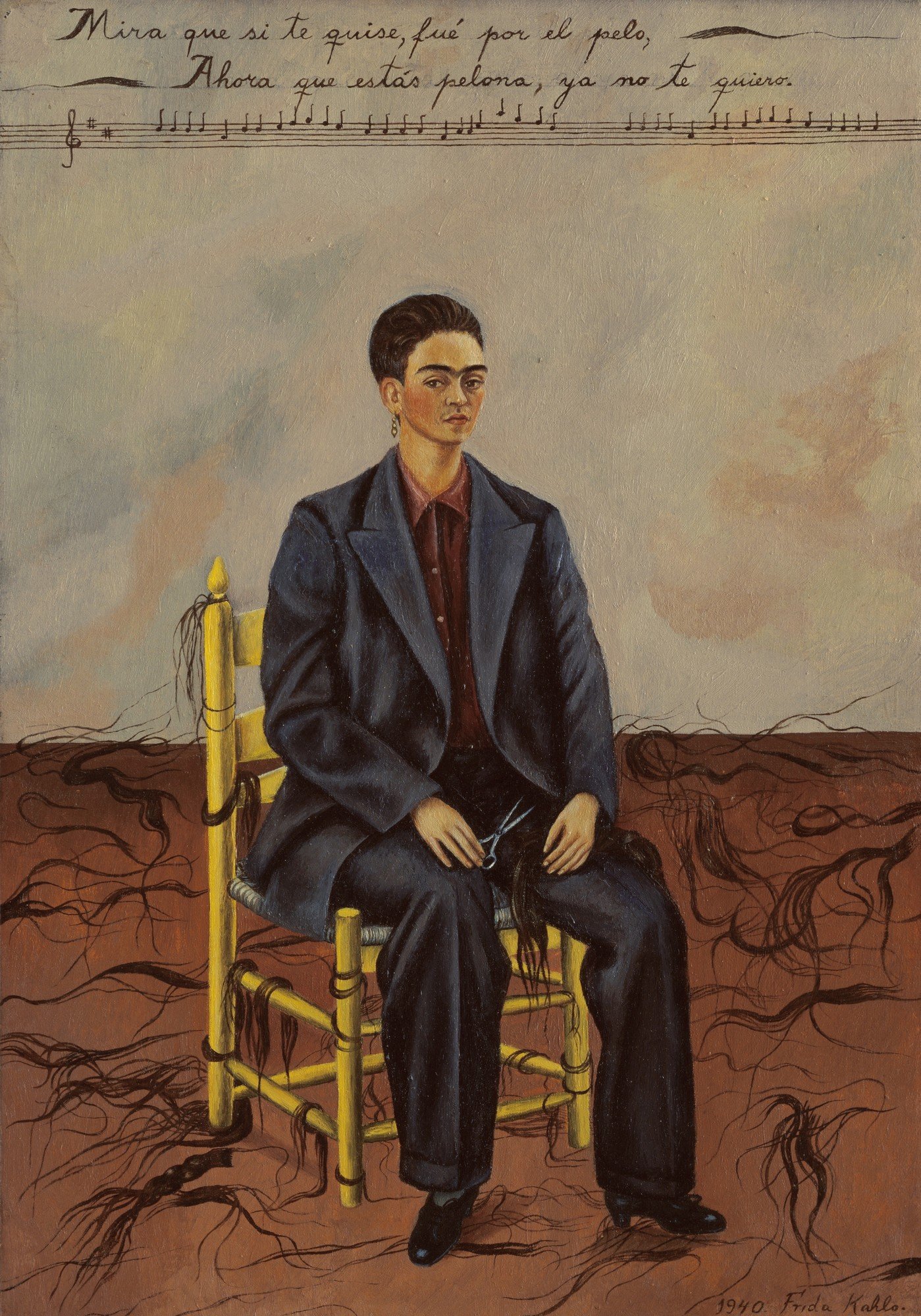Becoming Frida
Standing in the shadow of a man is no place to be for a woman. Especially not for a woman like Frida Kahlo. Shortly after divorcing mural artist Diego Rivera, Kahlo painted Self-portrait with Cropped Hair (1940), a reflection of the life and love she left behind – and the strength of the woman she was becoming.
Illustrasjon 1: Self-portrait with cropped hair, 1940.
“Look, if I loved you it was because of your hair. Now that you are without hair, I don’t love you anymore,” are the Mexican folk song lyrics written across the top of Frida Kahlo’s expressive self-portrait from 1940. The year before, in 1939, the iconic Mexican artist divorced her husband Diego Rivera, a mural artist who in his own time was considered an international art celebrity. Shortly after the divorce from her husband, Frida marked the collapse of her marriage by painting Self-portrait with Cropped Hair. The painting shows a somewhat content Frida lounging back on a yellow chair, wearing what we can only assume is one of Rivera’s oversized dark suits. As we recognize from many of her other self-portraits, Frida’s outbound gaze is what draws the spectator inwards, almost distracting us from the surreal landscape that surrounds her. In the painting, Frida is shown with a pair of scissors in one hand and a lock of her chopped off hair in the other, her discarded locks laying all around her. Frida was well aware that Diego had always admired her long dark hair, and thus in a surrealist fashion, the almost animate locks of hair scattered across the floor can be read as a representation of Frida’s estrangement from Rivera as she tried to distort the aspects of her physical appearance that attracted him. This masculine image of Frida is quite different from her appearance in many of her previous self-portraits, where she has painted herself wearing the traditional Tehuana dress and with flowers in her long braided hair. Just as Diego loved to see her.
After the separation from Diego, Frida chose to abandon her feminine image, and in the following years Kahlo vowed to support herself financially by selling her own work. She became an early heroine of the Women’s Movement because of her ability to exorcise traumatic events in paintings, where she reveals the inner and tabooed aspects of the female body. In the years following her very successful first solo-exhibition at the Julien Levy Gallery in New York in 1938, Frida traveled to Paris to show her work, hanging out with Surrealist superstars such as André Breton and Marcel Duchamp. This move ultimately led to the Louvre acquiring one of her works, The Frame (1938), making Kahlo the first 20th Century Mexican artist to be included in the museum’s collection.
…
Although Frida and Diego ended up remarrying the same year Self-Portrait with Cropped Hair was finished, the painting marked a new direction in Kahlo’s artistic career. She would no longer be known as “the wife of the Mexican Mural painter Diego Rivera”, but as Frida Kahlo – a self-made Surrealist and an independent artist.
Illustrasjoner:
Illustrasjon 1: Self-portrait with cropped hair, 1940. Oil on canvas, 40 x 27,9 cm. Gift of Edgar Kaufmann, Jr. Acc.n.: 3.1943. © 2020 Banco de México Diego Rivera Frida Kahlo Museums Trust, Mexico, D.F. / Artists Rights Society (ARS), New York.
Litteraturliste
Carson, Fiona. "Feminist Debate and Fine Art Practices." In Feminist Visual Culture, edited by Fiona Carson and Claire Pajaczkowska, 25-36. Edinburgh: Edinburgh University Press, 2000. Accessed September 1, 2020. doi:10.3366/j.ctvxcrs42.8.
Cocks, Neil. "On Frida Kahlo´s Moustache: A Reading of Self-Portrait with Cropped Hair and Its Criticism." In The Last Taboo: Women and Body Hair, edited by Karen Lesnik-Oberstein, 191-208. MANCHESTER; NEW YORK: Manchester University Press, 2006. Accessed September 1, 2020. http://www.jstor.org/stable/j.ctt155j918.16.
Roberts, Jodi. Moma.org. NY: MoMA, 2016.
Zelazko, Alicja. Encyclopædia Britannica.
This text is dedicated to Sara Oktave Berg Svendsen, my best friend and my rock in life, and a great admirer of Frida Kahlo.

